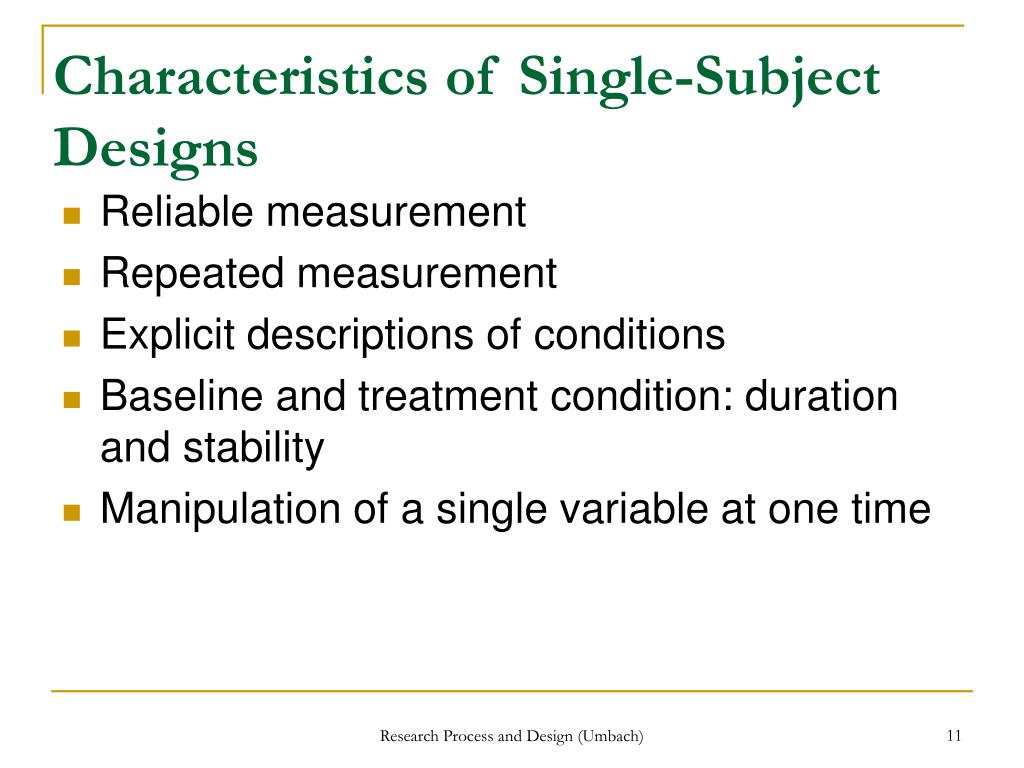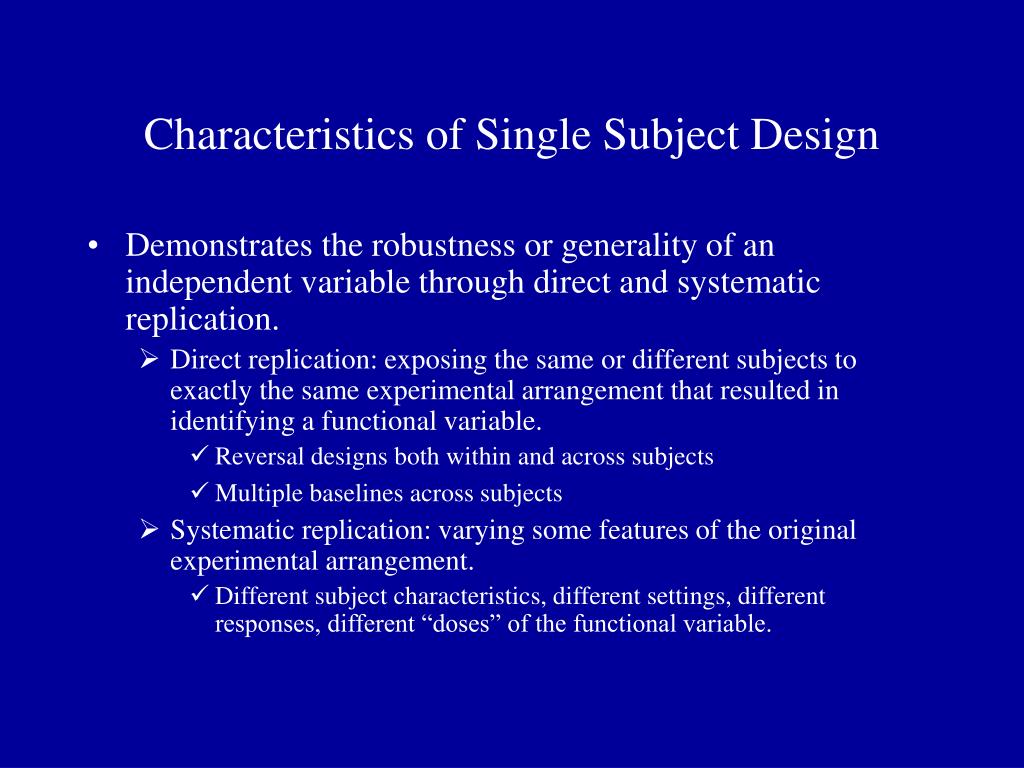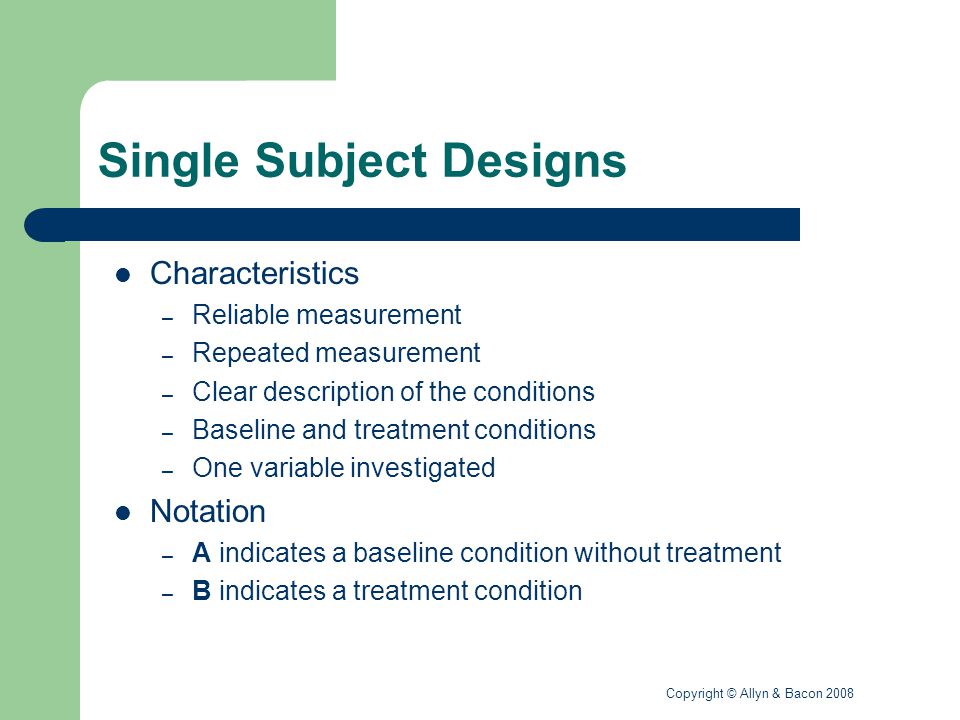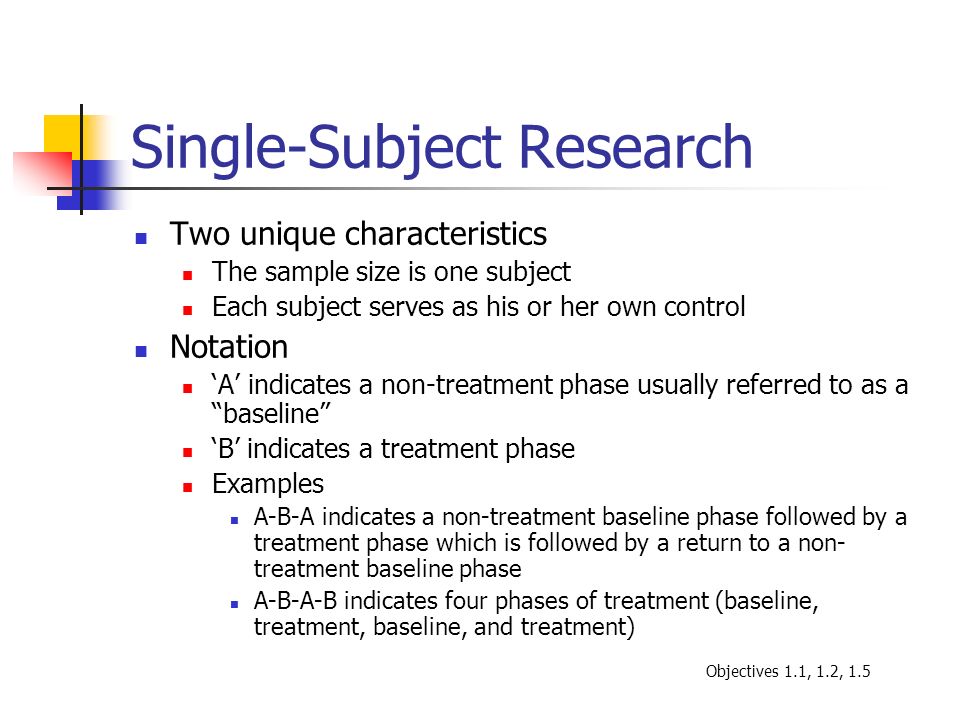Download Table Single subject design participant demographic characteristics from publication. Since these designs contain many measures of behavior it is important to have reliable.

Single Subject Design Ppt Download
This phase is different from most experiments in.

. Specifically I will discuss a the history of single-subject designs in psychology b problems with large-N designs and why single-subject designs have regained some popularity in the past 30 to 40 years c characteristics shared by different single-subject designs and d some of the most common single-subject designs. Single-subject experimental designs SSEDs represent an important tool in the development and implementation of evidence-based practice in communication sciences and disorders. This flexibility allows progress to be evidence-based practices.
Researchers use single-subject design because these designs. Characteristics of Single-Subject experimental designs SSEDs Small number of participants Importance of individual differences. Characteristics of single subject design 1 Reliable measurement.
The home TEACCHing program for toddlers with autism The study evaluated the. The researcher repeatedly assesses the DV across various phases of the experiment. During the first phase A a is established for the dependent variable.
Single-blind and double-blind designs In a follow-up study you use a between-subjects single-blind design. First such designs can demonstrate clear causal relations between intervention and behavior change. McMillan Reference McMillan 2004 identified five defining characteristics of single-subject designs that rendered them an appropriate method for research within this field.
Despite their limited use single-subject research designs have significant methodological advantages over large-sample research designs that could be used to facilitate more rapid clinical research advances. Published on March 12 2021 by Pritha BhandariRevised on September 3 2021. It is more typical for there to be somewhere between two and 10 participants.
In design of experiments single-subject curriculum or single-case research design SCED is a research design most often used in applied fields of psychology education and human behavior in which the subject serves as hisher own control rather than using another individualgroup. Before looking at any specific single-subject research designs it will be. All of the following are characteristics of single-subject experimental designs SSEDs except.
These characteristics include the use of repeated measures over a minimum of two conditions inclusion of a baseline and treatment condition reliable means of measurement explicit. Single-subject designs appropriate for the needs of the special education field. Up to 10 cash back This article reports the results of a study that located digitized and coded all 809 single-case designs appearing in 113 studies in the year 2008 in 21 journals in a variety of fields in psychology and education.
Single-subject experimental designs also referred to as within-subject or single case experimental designs are among the most prevalent designs used in CSD treatment research. Graphing the data facilitates monitoring and evaluating the impact of the intervention. Is a type of quantitative research that involves studying in detail the behaviour of each of a small number of participants.
A small number of participants b repeated measurement of the dependent variable c logical generality d positive correlation e visual inspection of data. In a between-subjects design or a between-groups design every. The y axis is used to represent the scores of the dependent variable whereas the x axis represents a unit of time such as an hour a day a week or a month.
3 Description of. You may have a greater risk of demand characteristics in a single-blind design compared to a double-blind design. Data collected prior to during and following the intervention allow measurement of changes.
A placebo pill vs a new medication are applied. Another advantage of using single-subject designs is the Single-subject designs are a rigorous scientific methodol- flexibility of these designs to adapt to varying situations and ogy used to define basic principles of behavior and establish educational settings. Do not have adequate control for the factors that affect the internal validity of an experiment AB design - ONLY pre-experimental design.
Some participants are assigned to a control group while others are in a treatment group. The same behavior is measured repeatedly. These designs provide a framework for a quantitative scientifically rigorous approach where each participant provides his or her own experimental control.
Between-Subjects Design Examples Pros Cons. First single-subject designs are focused on individual level and do not require populations. The basic argument is to establish an operator level to introduce the independent variable to focus on any change in the response.
The phases of a single-subject design are almost always summarized on a graph. Note that the term single-subject does not mean that only one participant is studied. Coded variables included the specific kind of design number of cases per study number of outcomes data points and phases per.
The purpose of this article is to review the strategies and tactics of SSEDs and their application in speech-language pathology research. Characteristics of Single-SubjectSystem Designs According to Kratochwill and Williams 1988 single-case experimental designs have following five characteristics. Benefits of Single Subject Design Study low incidence populations and behaviors Cost effective Evaluate intervention prior to large scale study Flexible design is adaptable to situation Can be conducted in practice settings Test clinical hypotheses Monitor progress in applied settings Limitations of Single Subject Design.
Single subject research designs are weak when it comes to external validityStudies involving single-subject designs that show a particular treatment to be effective in changing behavior must rely on replicationacross individuals rather than groupsif such results are be found worthy of generalization Fraenkel Wallen 2006 p. Single-Subject Research Designs General Features of Single-Subject Designs. Types of Single Subject Design 1 Withdrawal design As the name implies the experimental treatment started after the baseline period is withdrawnTreatment can be presented systematically and can be withdrawn in many ways.
In experiments you test the effect of an independent variable by creating conditions where different treatments eg. This is the level of.

Ppt Experimental Research Designs Part 2 Powerpoint Presentation Free Download Id 315673

Quasi Experimental And Single Case Experimental Designs Ppt Download

Single Subject And Correlational Research Bring Schraw Et Al Ppt Download

Ppt Single Subject Research Design In A School System Powerpoint Presentation Id 726774

Single Subject Research Ppt Download

Ppt Single Subject Research And Evidence Based Interventions Are Ssds Really The Ugly Stepchild Powerpoint Presentation Id 352941

Experimental Research Designs Ppt Video Online Download

Single Subject Experimental Research Ppt Video Online Download
0 comments
Post a Comment